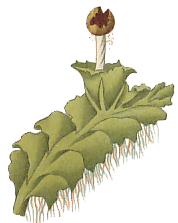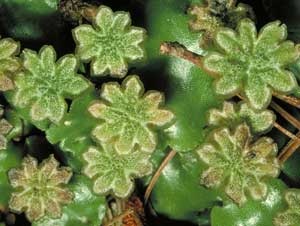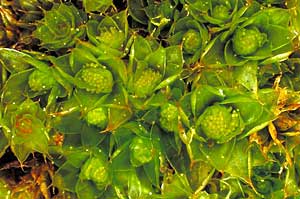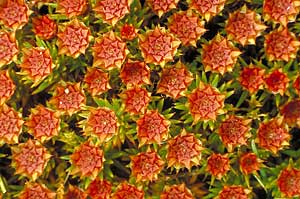
Reproduction & dispersal – Sexual reproduction
Liberation & dispersal of sperm
This page is divided into two sections. The first looks at the liberation of the sperm mass from the antheridia. The second gives an account of some of the ways in which the sperm mass is dispersed further afield.
Liberation of sperm mass
Hornwort antheridia are contained within embedded chambers in the hornwort thallus. Before maturity there's a narrow "roof" between that chamber and the outside world. When an antheridium matures the swelling slime content in the "roof" cells causes them to roll out, thereby creating a channel between the antheridial chamber and the outside world. Now, when the roof cells in a mature antheridium break down, the sperm mass inside oozes out onto the surrounding thallus. In the other bryophytes the antheridia are not totally enclosed within the sorts of chambers found in hornworts. Thus, the others have no "roof" that needs dissolution to open a passage between the antheridia and the outside world. In the complex thallose liverwort genus Riccia the mature sperm lie free within the antheridium, within a viscous fluid. When the top of an antheridium opens the sperm-containing mucilage oozes out of the antheridium, onto the thallus![]() .
.
This picture ![]() shows several blackish antheridial pads of Lunularia, one clearly showing a milky sheen, from one or more sperm masses that have extruded from the antheridia within the pad. In Marchantia the sperm masses may also ooze onto the raised, star-like antheridial pads (right), each of which contains numerous antheridia. However it has been reported that in the species Marchantia polymorpha, Preissia quadrata and Reboulia hemispherica the sperm mass may be shot 2 to 5 centimetres into the air and in Monoclea forsteri 6 to 8 centimetres. It is reported that mucilage cells within the antheridia of Monoclea forsteri swell up and cause the explosive release. Monoclea forsteri is the largest thallose liverwort, with thallus lobes to 5 centimetres wide and 20 centimetres long. It is widespread in shaded, streamside habitats in New Zealand and is also found in parts of the Americas from the Caribbean to South America. Regarding sperm release this website: states: "A male thallus forms sperm within circular regions which are splashed into the air by falling rain drops". Perhaps the sperm of this species are released explosively or passively, depending on circumstances. In the complex thallose species Conocephalum conicum the sperm mass is ejected very forcibly, up to 12 centimetres into the air and over an area up to half a metre wide. In Asterella californicum the explosive discharge is reported to shoot the sperm mass 14 to 20 centimetres vertically. In this species not only the sperm mass but also the antheridial cells and even some of the surrounding tissue may be shot away. In those cases where the explosive mechanism has been thoroughly studied the driving force appears to be mucilage cells in the antheridia. These cells readily take up water and swell, so building up considerable pressure within the antheridia
shows several blackish antheridial pads of Lunularia, one clearly showing a milky sheen, from one or more sperm masses that have extruded from the antheridia within the pad. In Marchantia the sperm masses may also ooze onto the raised, star-like antheridial pads (right), each of which contains numerous antheridia. However it has been reported that in the species Marchantia polymorpha, Preissia quadrata and Reboulia hemispherica the sperm mass may be shot 2 to 5 centimetres into the air and in Monoclea forsteri 6 to 8 centimetres. It is reported that mucilage cells within the antheridia of Monoclea forsteri swell up and cause the explosive release. Monoclea forsteri is the largest thallose liverwort, with thallus lobes to 5 centimetres wide and 20 centimetres long. It is widespread in shaded, streamside habitats in New Zealand and is also found in parts of the Americas from the Caribbean to South America. Regarding sperm release this website: states: "A male thallus forms sperm within circular regions which are splashed into the air by falling rain drops". Perhaps the sperm of this species are released explosively or passively, depending on circumstances. In the complex thallose species Conocephalum conicum the sperm mass is ejected very forcibly, up to 12 centimetres into the air and over an area up to half a metre wide. In Asterella californicum the explosive discharge is reported to shoot the sperm mass 14 to 20 centimetres vertically. In this species not only the sperm mass but also the antheridial cells and even some of the surrounding tissue may be shot away. In those cases where the explosive mechanism has been thoroughly studied the driving force appears to be mucilage cells in the antheridia. These cells readily take up water and swell, so building up considerable pressure within the antheridia![]() .
.
Explosive release is unknown in both the leafy and simple thallose liverworts. In these other liverworts the cells of the antheridial walls have a strong tendency to separate from each other when moist. Moist cells curve outward when wet and separate, opening the antheridium. The splitting or unfolding may be very quick. For example in Fossombronia (a simple thalloid liverwort) the mature antheridia burst suddenly, but though the bursting is sudden the release of sperm is not explosive. In some cases the opening and unfolding of the antheridium may be forceful enough for some of the antheridial cells to become detached, a phenomenon that has been seen in Porella![]() .
.
The three moss genera Polytrichum, Atrichum and Mnium have species in which fluid within antheridia helps with sperm release. Fluid builds up at the base of an antheridium (below the sperm mass) as the antheridium matures. This fluid is produced internally, rather then being absorbed from an external source. The fluid build up is quite noticeable in the first two genera, finally occupying about a third of the volume (on average) of a mature antheridium. In Mnium the fluid volume is much smaller and, at times, hard to see. Such a fluid build-up stretches the antheridial wall, which therefore stores potential energy. When the cells at the apex of the antheridium rupture the rapid contraction of the antheridial wall forces out much of the sperm mass. Any of the sperm mass that is left after such contractions is extruded more slowly, following uptake of water by the fluid at the base of the antheridia. In Polytrichum all the spore mass is commonly ejected by contraction, whereas in the other two genera some typically remains for the slower, extrusion process![]() .
.
In the moss Funaria hygrometrica there is also a two-phase sperm release, following the disintegration of the cells at the antheridial apices. However, the antheridia of Funaria hygrometrica lack the fluid present at the bases of the antheridia of Polytrichum etc. In Funaria the first ejection phase is governed by contractions of the antheridial walls. In the slow-release phase the remaining sperm are not pushed out by water uptake of internal antheridial fluid. Rather, they are pulled out because of the cohesiveness of the sperm mass and the swelling of the extruded portion (up to five times its volume when contained in the antheridium)![]() .
.
In a Sphagnum antheridium the apical cells absorb water and swell. The antheridium then opens via a number of irregular lobes which bend backwards to release androcytes. As in the case of the liverwort genus Porella, mentioned above, the unfolding of the lobes may be forceful enough to cause some of the antheridial cells to become detached.
Water is essential for the opening of the antheridia so must come into contact with the antheridia. Water is easily trapped in the leaf axils of mosses and leafy liverworts, so species which have antheridia in leaf axils are assured of water getting to the antheridia. Many mosses produce antheridia within cup-like leaf formations, as shown by the red antheridial cups of Polytrichum juniperinum ![]() . and the less-dramatic Rosulabryum billardieri (right). Antheridia are formed in those cup-like areas, which are excellent water traps. The antheridia-bearing pads of various thallose liverworts (e.g. Marchantia
. and the less-dramatic Rosulabryum billardieri (right). Antheridia are formed in those cup-like areas, which are excellent water traps. The antheridia-bearing pads of various thallose liverworts (e.g. Marchantia ![]() and Lunularia
and Lunularia ![]() ) have already featured above. These are also well-structured for water-holding, since they have slightly raised margins.
) have already featured above. These are also well-structured for water-holding, since they have slightly raised margins.
In the cases mentioned above where the spore mass is extruded, it leaves the antheridium as a cohesive, thread-like mass - a bit like toothpaste that is squeezed out of its tube. Experiments with a number of bryophytes have shown that when the sperm mass is forced out of an antheridium that is held underwater, the mass remains thread-like. Moreover, if kept underwater the sperm mass may stay cohesive for several hours. However, once the thread-like mass gets to the surface of the water the sperm mass spreads out very rapidly. In this process what was previously a cohesive stream breaks up into a multitude of individual sperm or sperm-containing cells. This rapid spreading over the surface is caused by the lowering of surface tension by fats within the sperm mass. So, for example, the sperm mass will be spread over a film of water in the moistened antheridial cups of a moss such as Polytrichum or on the wet antheridial pads of a liverwort such as Marchantia![]() .
.
Not all bryophytes have such fats and Conocephalum conicum and Sphagnum are two examples of bryophytes lacking such fats. In a species such as Conocephalum conicum the explosive ejection of sperm would make the fats redundant. The explosive release into the air would itself be enough to spread out the sperm mass.
Getting further away - to the archegonia
Where a sperm mass has been liberated into the near surrounds of the antheridia (e.g. onto the surrounding thallus, stems or into antheridial cups) there is still the matter of getting to the archegonia.
Bryophyte sperm cells are typically coiled and with two whip-like flagella at one end and these flagella give the sperm the ability to move of their own accord in water. Experimental studies have shown that some bryophyte sperm can move at speeds of 1 to 2 tenths of a millimetre per second and maintain mobility for several hours. So, in theory, they are capable of swimming 1-2 metres. Moreover, antheridia release their contents only in the presence of water, so when a sperm mass is released there will typically be at least a film of water present. However other experiments show that sperm may move very little of their own accord. In one experiment sperm were released into a pool of water one centimetre long and half a centimetre wide. After an hour a few individuals had moved the centimetre, but most were still crowded near the point of release![]() .
.
In the absence of other factors, sperm seem to move randomly. Archegonia produce chemicals that will attract the sperm into the archegonial canal and through to the egg. However, such chemical attraction works over a relatively short range, so the sperm need to be fairly close to an archegonium for the sperm to follow a chemically-directed, rather than random, course. The experimental evidence therefore indicates that bryophyte sperm need more than just their own swimming power to get close to the archergonia. Remember also that in many cases free sperm are not released from the antheridia. Rather, each sperm is still contained within a cell, with liberation of the sperm happening sometime after the opening of the antheridium. In many cases it is a fairly simple process of moving water carrying the sperm (or sperm-containing cells) away from the antheridia. Earlier you saw that in many bryophytes a sperm-mass is extruded from an antheridium and within that sperm mass there are fats which promote the rapid break-up of the mass at the water surface. The individual components are much more easily dispersed by water than would be the case with a cohesive mass.
In some other bryophytes there may be a little bit more complexity to sperm dispersal. The photo (right) shows a colony of the moss Polytrichum juniperinum . It is a tufted moss that grows on soil and this photo was taken from above, looking straight down on the colony. The red-rosettes at the tops of the stems are composed of pigmented leaves, with the other leaves on each stem being green. The leaves that make up the red rosettes are very stiff and so form a fairly robust, cup-like structure, often about 5mm in diameter. The antheridia occur within that whorl of leaves and discharge the sperm-mass into the water-filled, reddish cup. From there raindrops can splash the sperm cells further away. Fats within the sperm masses have ensured that the masses have broken up, so making it easier for a falling drop to dislodge some of the sperm cells. The same splash-cup mechanism is used by various other species related to Polytrichum juniperinum , though the splash cups are not so strikingly coloured. These mosses belong to the family Polytrichaceae. In some members of the family, the splash-cup mechanism may carry the sperm up to 1.5 to 2 metres away, though most splashes will land much closer. Similar antheridial-containing rosettes are found in various other mosses as well and there's more in the SPLASH CUP SECTION.
There have been some studies showing that insects and other invertebrates may transfer sperm. Observations have shown that various invertebrates (mites, springtails, midges, leaf-hoppers and aphids) visit the antheridia-bearing rosettes of Polytrichum commune. The invertebrates feed on the mucilage produced by the paraphyses found amongst the antheridia. At times some of those invertebrates have even pierced the antheridia. While rummaging amongst the antheridia the invertebrates get smeared with mucilage in which are mixed viable sperm. Similar arrays of invertebrates, with bodies bearing a sperm-mucilage mixture, have also been found amongst the archegonia of the same moss species. In experiments with the moss Bryum capillare, females two metres away from the nearest male could be fertilized when insects were able to visit the female mosses. However, there was no fertilization when the female plants were covered with a very fine net that excluded insects![]() .
.
There have been few investigations into the question of how far away the sperm can travel to fertilize archegonia. A few distances were given above. Studies on temperate area mosses suggests that by and large fertilization distances are fairly short, say no more than about 10 centimetres. Mosses which utilize the splash cup mechanism generally have longer fertilization ranges than mosses without splash cups. As the Bryum capillare example shows, insects can carry the sperm further afield.
Bryophytes growing on trees may also have longer fertilization distances. It's easy to see that if, for example, there's a colony of male plants higher up a trunk than a colony of female plants, rainwater flowing down the trunk would quickly carry sperm from the males to the females. In tropical forests tree trunks, branches and leaves provide the best homes for bryophytes. In such areas the forest floors are often dark or with much litter fall, which would swamp any soil-inhabiting bryophytes and so deprive them of access to any light that does make it to ground level. Studies on the leafy liverworts on tropical forest trees have shown that fertilization over distances of 2 to 5 metres must be common. In some cases it's simply another case of water flowing down a trunk. However, in other cases it's clear that flowing water is not the agent. Instead, very fine, aerosol-like droplets are the sperm-dispersing agents. The very fine droplets found in the mists in tropical forests can stay airborne for quite a while and in that time even the slightest of breezes could waft the droplets considerable distances![]() .
.
![An Australian Government Initiative [logo]](/images/austgovt_brown_90px.gif)




